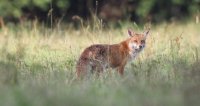Home > Field observatories > 4P (Landscape, Rodents , Predator and Parasite Populations)

4P (Landscape, Rodents , Predator and Parasite Populations)
Rodent/Predator/Environment Observation Network - ROPRE
If there is an agenda for rodent research in this century, it is to produce high-quality quantitative data over the long term for a variety of sites in temperate, polar, and tropical habitats
Charles Krebs (2013)
Context
Some species of small mammals (voles, but also rabbits, prairie dogs, pikas, etc.) have been traditionally perceived as pests and targeted for control on a very large scale. They are however key-stone species in their native ecosystems. Research conducted in the ZAAJ on Arvicola terrestris and Microtus arvalis ecology has shown that landscape composition and structure (e.g. the spatial arrangement of habitats) have important effects on the population dynamics of grassland voles. Those effects are multi-scale, and have indirect consequences on the vertebrate community (other small mammal species and predators including species of conservation value) and parasite transmission. This knowledge has practical applications for eco-friendly control of small mammal pests and conservation.

Objective
To monitor the population dynamics of water voles and common voles and their predators
Issues
 This activity feeds research on two sometimes contradictory control requirements:
This activity feeds research on two sometimes contradictory control requirements:
• population control for agronomic and public health reasons;
• consequences of vole outbreaks in conservation biology. Voles are important prey for numerous predators, including some protected and heritage species (red kite, etc.). Variations in vole abundance entail changes in diet for their predators which may have effects on species of game or heritage value (hare, capercaillie, etc.).
See the Arvicola terrestris travelling wave in the Doubs department (1989-2020)
Where and When
 Monitoring covers mountain water vole populations in the Doubs and Jura departments annually since 1989 (commune resolution); since 2004 spotlight counts (foxes, hares, etc.) based on a network of 472 transects in the Doubs department; index transects for montain water vole from 1990 to 2000, montain water vole, common vole and mole since 2014, in Spring and Autumn, mostly in the following communes: Levier, Septfontaines, Evillers, Le Souillot, Chapelle d’huin, Bulle, Chaffois et Bannans. From 1999 in the ZELAC (Zone expérimentale de lutte anti-campagnol, Sombacour and Bians-les-Usiers communes) and since 2005 in the CLAC (Charquemont lutte anti-campagnols, Charquemont, Les Écorces, Fournet-Blancheroche communes). Since 2016 in the ZERRAC (Zone Expérimentale de Régulation des Rongeurs en Agriculture de Conservation, communes of Annoire, Chemin, Petit-Noir, Saint-Aubin, Saint-Loup, Tavaux).
Monitoring covers mountain water vole populations in the Doubs and Jura departments annually since 1989 (commune resolution); since 2004 spotlight counts (foxes, hares, etc.) based on a network of 472 transects in the Doubs department; index transects for montain water vole from 1990 to 2000, montain water vole, common vole and mole since 2014, in Spring and Autumn, mostly in the following communes: Levier, Septfontaines, Evillers, Le Souillot, Chapelle d’huin, Bulle, Chaffois et Bannans. From 1999 in the ZELAC (Zone expérimentale de lutte anti-campagnol, Sombacour and Bians-les-Usiers communes) and since 2005 in the CLAC (Charquemont lutte anti-campagnols, Charquemont, Les Écorces, Fournet-Blancheroche communes). Since 2016 in the ZERRAC (Zone Expérimentale de Régulation des Rongeurs en Agriculture de Conservation, communes of Annoire, Chemin, Petit-Noir, Saint-Aubin, Saint-Loup, Tavaux).
Partnership
The work is carried out by a consortium of the Chrono-Environment research unit, the Regional Office for Food, Agriculture and Forestry, FREDON Bourgogne Franche-Comté and the Hunters Federations of the Doubs department.

Inter-ZA studies
 Studies based on the monitoring of Arvicola terrestris populations since 1998 are ongoing in the LTER site Alpes (Haute-Romanche and Haute Guisane) for comparisons with the Jura massif, with the collaboration of the communauté de commune du Briançonnais. They have been supported by the Fédération départementales du Doubs, du Jura, and the Ecrins National Parc from 2012 to 2015.
Studies based on the monitoring of Arvicola terrestris populations since 1998 are ongoing in the LTER site Alpes (Haute-Romanche and Haute Guisane) for comparisons with the Jura massif, with the collaboration of the communauté de commune du Briançonnais. They have been supported by the Fédération départementales du Doubs, du Jura, and the Ecrins National Parc from 2012 to 2015.

Data collected in Haute-Romanche are currently used to validate a multi-agent model whose design and development have been carried out jointly by Chrono-environment (Patrick Giraudoux) and FEMTO-ST (Nicolas Marilleau and Christophe Lang).
- Historical agricultural changes and the expansion of a water vole population in an Alpine valley
- Coupling agent-based with equation-based models to study spatially explicit megapopulation dynamics
Read more...
Coordinator : Patrick Giraudoux
Chrono-Environment Laboratory – University of Franche-Comté














